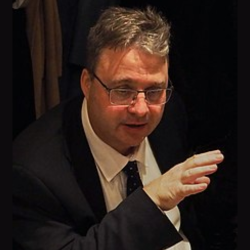Biography
Prof. Crispin H. W. Barnes is a Professor of Quantum Physics at the Cavendish Laboratory and a Professorial Fellow of Girton College, Cambridge. He joined the Cavendish Laboratory in 1994, and prior to that was a research scientist in the Nanoelectronic group at RIKEN, Japan and a Royal Society Postdoctoral Fellow at Simon Fraser University, Canada. He completed his Ph.D in 1991 at Imperial College, London and has a 30 year track record in condensed matter physics research and engagement with industrial partners. He currently has funded projects with Mursla Ltd, Cambridge Biomagnetics Ltd, The National Physical Laboratory, Hitachi Cambridge Laboratory, The Satellite Applications Catapult and Nu Quantum. He was awarded the Brian Mercer Feasibility Award in 2014 for his work on magnetic microcarrier tags. He teaches two lecture courses; Quantum Information, and Advanced Quantum Condensed Matter Physics in Part III at the Cavendish Laboratory.
Research
Prof. Barnes works on materials physics [1-3], thin-film magnetic microstructures [4], quantum device physics [5-7], quantum information theory [8] and environmental physics [9].
Since 2008, Prof. Barnes has run a materials growth facility at the Cavendish Laboratory, maintaining a number of bespoke molecular beam epitaxy systems with both insitu and exsitu analysis. It has allowed his group to study a wide variety of materials systems from magnetic oxides to topological insulators. He also runs a cleanroom and a low-temperature measurement facility that has enabled his group to both fabricate electronic microstructures and quantum devices structures and measure their electrical transport and optical properties from room temperature to 1.3K.
Since 2010 Prof. Barnes has built and run a number of bespoke, state-of-the-art GPU servers, funded mainly by Hitachi Cambridge. He and his group have considerable expertise in numerical modelling of quantum device structures and the simulation of quantum computers and quantum communication protocols. The group regularly use the IBM quantum computers.
In 2017 Prof. Barnes created an Environmental Physics Group in collaboration with three Peruvian universities; Moquegua UNAM, Barranca UNAB and Canete UNDC. This group has made analyses of river water, sediments, plants and bird life in the four river catchments near these universities. The group has developed; practical methods to do environmental impact studies in extreme environments, a new type of assay test using DNA to detect water born mercury as well as other metals, field technologies using drones and satellite imaging, and new statistical methods to deal with large environmental data sets.
Publications
[1] Systematic Study of Ferromagnetism in CrxSb2−xTe3 Topological Insulator Thin Films using Electrical and Optical Techniques, Singh A., Kamboj V., Liu J., Llandro J., Duffy L.B., Senanayak S.P., Beere H.E., Ionescu A., Ritchie D.A., Hesjedal T., Barnes C.H.W. Scientific Reports, 8, 17024 (2018).
[2] Nonmonotonic aftereffect measurements in perpendicular synthetic ferrimagnets
Fache T., Tarazona H.S. , Liu J., L'vova G., Applegate M.J., Rojas-Sanchez J.C., Petit-Watelot S., Landauro C.V., Quispe-Marcatoma J., Morgunov R., Barnes C.H.W., Mangin S., Phys. Rev. B, 98 064410, (2018).
[3] Structure and magnetic properties of an epitaxial Fe(110)/MgO(111)/GaN(0001) heterostructure Khalid N., Kim J.Y., Ionescu A., Hussain T., Oehler F., Zhu T., Oliver R.A., Farrer I., Ahmad R., Barnes C.H.W. J. Appl. Phys. 123, 103901, (2018).
[4] A composite element bit design for magnetically encoded microcarriers for future combinatorial chemistry applications, Love D.M., Vyas K.N., Fernandez-Pacheco A., Llandro J., Palfreyman J.J., Mitrelias T., Barnes C.H.W. RSC Advances, 5 p10211-10218 (2015).
[5] Bi2Se3 topological insulator quantum wires, Nikolic, A.; Barnes, C. H. W. J. Phys. Comm, 2, 095007 (2018).
[6] Quantum ballistic transport in strained epitaxial germanium, Gu Y., Holmes S.N., Newton P.J., Ellis D.J.P., Morrison C., Pepper M., Barnes C.H.W., Myronov M. Appl. Phys. Letters, 111, 233512, (2017).
[7] Ground-State Electronic Structure of Quasi-One-Dimensional Wires in Semiconductor Heterostructures, Owen E. T., Barnes C. H. W. Phys. Rev. Applied 6 054007 (2016).
[8] Evaluation of counterfactuality in counterfactual communication protocols Arvidsson-Shukur D. R. M., Barnes C. H. W., Gottfries A. N. O. Phys. Rev. A 96, 062316 (2017).
[9] Paramagnetism in Bacillus spores: Opportunities for novel biotechnological application, Zhou K.X. , Ionescu A., Wan E., Ho Y.N., Barnes C.H.W., Christie G., Wilso D.I., Biotechnology and Bioengineering, 115, p 955-964 (2018).
Full publication list can be found at: https://scholar.google.co.uk/citations?user=m9thVwgAAAAJ

